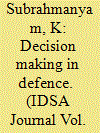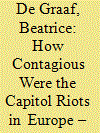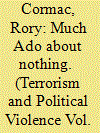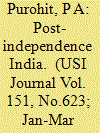|
|
|
Sort Order |
|
|
|
Items / Page
|
|
|
|
|
|
|
| Srl | Item |
| 1 |
ID:
176966


|
|
|
| 2 |
ID:
188044


|
|
|
|
|
| Summary/Abstract |
Research suggests that lone-actor terrorists and mass murderers may be better conceptualized as lone-actor grievance-fueled violence (LAGFV) offenders, rather than as distinct types. The present study sought to examine the extent to which these offenders could (or could not) be disaggregated along dimensions relevant to the threat assessment of both. Drawing on a Risk Analysis Framework (RAF), the offending process was theorized as interactions among propensity, situation, preparatory, leakage and network indicators. We analyzed a dataset of 183 U.S. offenders, including sixty-eight lone-actor terrorists and 115 solo mass murderers. Cluster analysis identified profiles within each of the components: propensity (stable, criminal, unstable), situation (low stress, high stress (social), high stress (interpersonal)), preparatory (fixated, novel aggression, equipped, clandestine, predatory, preparatory), leakage (high leakage, low leakage), and network (lone, associated, connected). Bi-variate analysis examined the extent to which the profiles classified offenders previously labeled as lone-actor terrorists or mass murderers. The results suggest that while significant differences may exist at the periphery of these dimensions, offenders previously classified as lone-actor terrorists or mass murderers occupy a noteworthy shared space. Moreover, no profile classifies a single “type” of offender exclusively. Lastly, we propose a dynamic, interactional model of LAGFV and discuss the implications of these findings for the threat assessment and management of LAGFV offenders.
|
|
|
|
|
|
|
|
|
|
|
|
|
|
|
|
| 3 |
ID:
182997


|
|
|
|
|
| Summary/Abstract |
This contribution presents a short overview on the impact of the Capitol Riots riots in Europe. Fear of a similar mass-mediated contagion was explicitly expressed by most of the European leaders. Echoes and acclamation for the riots in the U.S. were indeed heard on websites, QAnon-sites, and within circles of Trump supporters in Europe as well. An earlier storming of the German Reichstag (in 2020) was cited. In the Netherlands, the curfew riots of 24–25 January 2021 also were put into this context. Security agencies and officials in the U.K. and the Netherlands repeated this threat awareness in recent, formal threat assessments.
|
|
|
|
|
|
|
|
|
|
|
|
|
|
|
|
| 4 |
ID:
146624


|
|
|
|
|
| Summary/Abstract |
The anchoring effect is a well-studied subject. This article connects the effect with the rules-in-use within a military intelligence institution. Particularly the rules-in-use that dictate that an analyst takes his or hers starting point from recently conducted assessments of the specific area or threat. The threat assessment as well as the written assessment were affected. The results show that officers have an aversion to lower a previous given threat assessment. This gives that to understand risk assessment we not only need to understand the methods used, we also need to understand the institutions in which they are used. This is especially relevant for military intelligence as the assessments are conducted in an environment of high uncertainty.
|
|
|
|
|
|
|
|
|
|
|
|
|
|
|
|
| 5 |
ID:
121905


|
|
|
|
|
| Publication |
2013.
|
| Summary/Abstract |
Through its ability to transcend not only national boundaries but so too departmental jurisdictions and the traditional public-private security divide, the rise of international terrorism in the late 1960s and early 1970s posed a number of challenges to the British intelligence machinery which remain relevant today. This article focuses on the dangers and mechanics of threat exaggeration and the importance of intelligence coordination to ensure that threats are assessed and reports are disseminated in a realistic manner. Using the over-emphasised threat of maritime terrorism in 1970 as a case study, this article is able to examine the intelligence cycle as a whole and consider the importance of source validation, the dangers of incremental analysis, and the need for coordinated advice disseminated coherently to consumers both inside and outside of the government.
|
|
|
|
|
|
|
|
|
|
|
|
|
|
|
|
| 6 |
ID:
179359


|
|
|
|
|
| Summary/Abstract |
The issue of jointmanship in the Indian Armed Forces assumed greater salience with Revolution in Military Affairs (RMA) and enhanced threats including collusive ones. Although unanimously agreed as a necessity, the perceptions about jointmanship vary across the Services. Analysis of jointmanship exhibited during wars, conflicts and major operations reveals a mixed bag — mainly divergent at the military strategic level yet reasonably good coherence, coordination and execution at the tactical level. To jointly outfight the enemy, the article infers the need of establishing sound Civil-Military Relations (CMR), realistic threat assessment, enhancing joint training, jointly developing capabilities, and rejuvenating existing mechanisms, especially at the strategic level. Importantly, it highlights the difference good leadership and a robust Professional Military Education (PME) makes in enhancing jointness, both in peace and war.
|
|
|
|
|
|
|
|
|
|
|
|
|
|
|
|
| 7 |
ID:
175718


|
|
|
|
|
| Summary/Abstract |
This article describes the use of “red teaming” to analyze and forecast biological threats to U.S. national security. Red teaming is a method whereby participants adopt an adversarial perspective, and is used to stimulate critical and creative thinking without some of the flaws of other types of threat assessments, including mirror-imaging. Red team analysis is prevalent in the military, security, and commercial realms. There have been widespread calls from government and private organizations to analyze biological threats with a red teaming approach, in order to prioritize resources and to counter a wide array of biological agents. This paper includes a timeline of historical examples of both biological red team simulations and vulnerability probes, and discusses the challenges of conducting realistic, cost-effective modeling of biological agents. Finally, we propose additional analytical tools to the UK Ministry of Defense’s red team framework for the future development of structured, biological red team exercises, and discuss other existing future-oriented threat assessments in this realm.
|
|
|
|
|
|
|
|
|
|
|
|
|
|
|
|
|
|
|
|
|